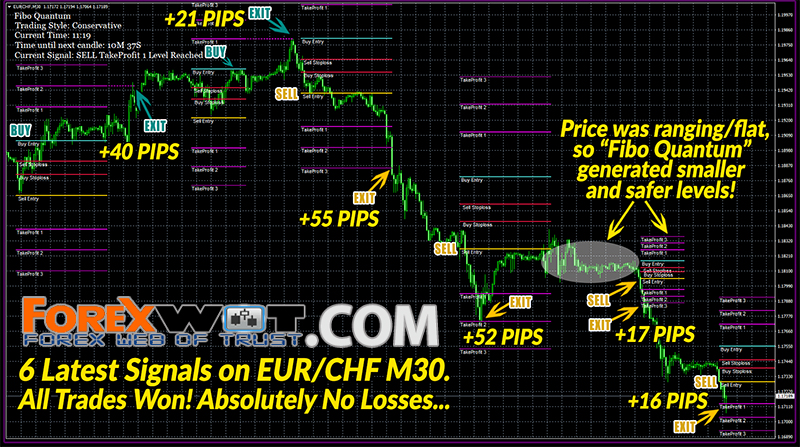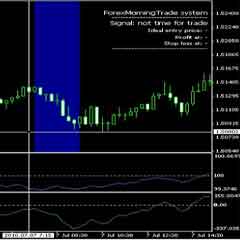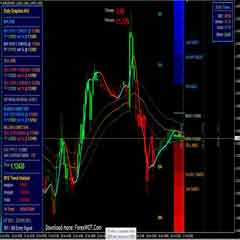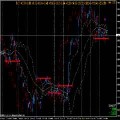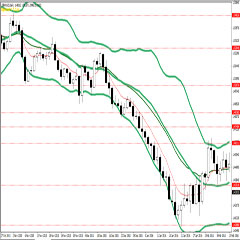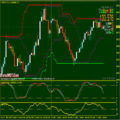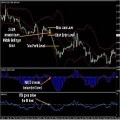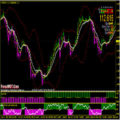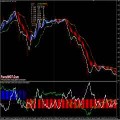Learn How To Profit in 30 Minute Time Frame – Hi guys, today I’ve got a great trading system for you called Forex Profit Fusion. This system ranked 2nd place in our SFTC v.6 Demo round. It’s very colorful as you will see and uses seven common standard MT4 indicators.
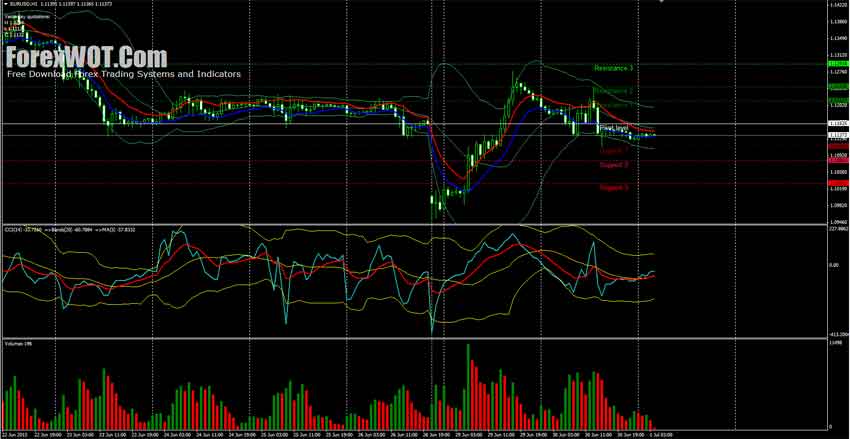
Some of which have been combined to produce a very unique way of reading the market. It also uses the volume indicator to gauge when it’s the right time to trade. This system trades the 30 minute time frame while taking the 4h time frame into account for trend direction.
At first glance, the charts might look pretty messy but once you spend a little bit of time with it, usually no more than an hour or two, you’ll start to see that it’s not so bad. I’ll walk you through each of the rules step-by-step so you’ll have a firm grasp of what to look for and the kinds of trading opportunities that this system provides.
Over the next pages you’ll be introduced to a unique method of plotting support and resistance while taking into account the bigger trend on the higher time frame.
You’ll even be able to identify range-bound markets when they present themselves as well as having opportunities to trade against the main trend. So let’s get started, shall we?
Forex Profit Fusion is a medium complexity approach and would suite those who love to tinker with indicators and like to have a lot of information on their charts.
It also uses trailing stops and the take profit levels are more dynamic and is very much in tune with what is going on in the market at any particular time.
This is a great system for intermediate to advanced traders because it is more complicated and takes a bit of practice to master.
That being said, every trader would benefit from this approach to trading and can be considered a more complete approach as we can trade reversals along with regular and hidden divergence.
It is even well developed for a bit of scalping when searching for signals.
The first thing that we need to do is open up the 4h chart and see where price is at and gauge our trend direction from the main chart moving averages.
We will do this by seeing if the 5 period smoothed high/low bands are above or below the middle Bollinger Band. On the 4h chart below we can see that price was in a down trend as the high/low bands were below the middle Bollinger band.

Next we will want to check to see where price is at in relation to our daily Pivot Points. We can also see that price was butting up against resistance at the R1 pivot level as well as the middle Bollinger Band and the upper moving average of our high/low band.
This provided a SIGNIFICANT AREA OF RESISTANCE. We can also see that we have lower highs on price as well as higher lows on the CCI. This is hidden bearish divergence which is trend following and indicates a move downwards.
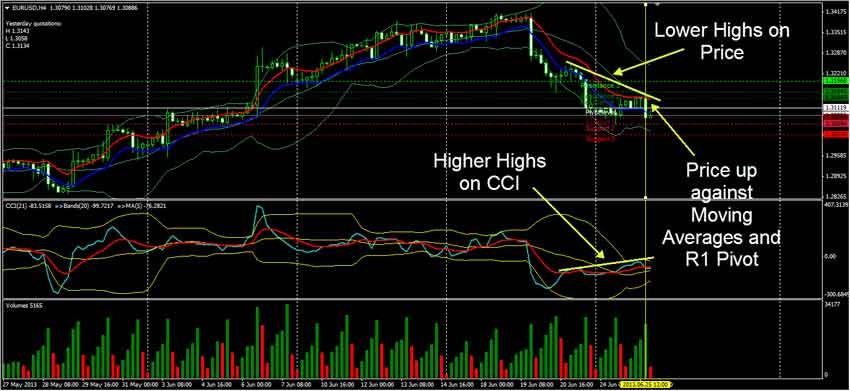
Next we will drop down to the 30 minute chart. This is where our volume indicator comes into play. We want to make sure that we have plenty of volume, meaning that we want to see it forming significantly higher or making consecutive higher highs.
Once we’re on the 30 minute chart and we’ve confirmed that we’ve got plenty of volume and that price is near a support or resistance area we can look for price action to confirm our trade.
This can come in the form pin bars, doji’s, engulfing candle patterns or any other of your favorite price action triggers. If there are no price action triggers we can look to the first indicator window and see if there is divergence.
On the EurUsd 30 minute chart below we can see that price hit the same resistance point 3 times and on the third time it dropped like a rock on the heels of a bearish engulfing candle pattern as well as divergence on the CCI.
Price made a valiant attempt at reaching the same level as it did before missing it by 7 pips. This can be considered a double top. The CCI however just didn’t have the steam to reach the same previous high. This is an exaggerated form of regular bearish divergence.
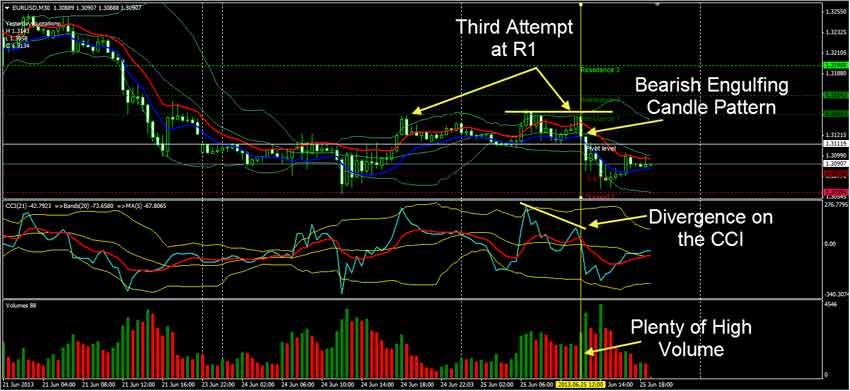
Once we get the bearish engulfing candle pattern we can see that the divergence on the CCI is confirmed as it crosses down the 5 smoothed moving average. We can then target the pivot level or the next support level which in this case was S1.
As you can see price made a very strong move down to S2 but didn’t quite make it. However, this trade still played out very well. As you can also see from this image S2 was a very strong level of support as price touched it once the day before and bounced dramatically.
The same way we identified the down trend on the 4h from the above example is the same way we’ll do it for uptrends.
First we’ll look at the 4h chart and see where the 5 smoothed high/low bands are in relation to the middle Bollinger Band on the main chart. On the 4h UsdCad chart below we can see that the high/low bands are well above the middle Bollinger Band and have been for quite some time indicating a strong up trend.
Next we’ll take note of where price is in relation to our pivot levels. In this case price is near S1 on the previous candle, which is a doji, as well as near the bottom high/low band and very close to the middle Bollinger Band.
This is indicating a strong level of dynamic support. Next we’ll take a look at the CCI for any divergence and will take note that the market is making higher lows while the CCI is making lower lows. This is how we define hidden bullish divergence.

Since we’ve defined the trend as being up on the 4h chart and that price is near substantial support along with hidden bullish divergence we have strong reasons to believe that the 30 minute chart holds the key for entering a nice buy trade.
On the 30 minute chart below we can see that price bounced off the S2 pivot level and got stuck between it and the S1 pivot level.
Once S1 was broken, price subsequently broke above the high/low bands and the CCI had already began moving up above the 5 smoothed moving average and was on its way to break the middle Bollinger Band in indicator window 1.
Once this took place price broke outside of its short range and we can enter the market with a stop below the previous candle as this provided a very tight swing.
Our target could have been the pivot level or R1, both of which were easily hit. It is important to note that we had plenty of volume at this time as well since this trade occurred during a very active portion of the market.

- Check the Trend on the 4 hour chart. If the SMMA challel is below the Middle Bollinger Band, the market is in a down trend.
- Next, go to the 30 minute chart and wait for price to approach a Resistance area.
- If there are no price action patterns to trade, check to see if there is divergence present between Price and the CCI/BB/SMMA window on the 30 minute time frame.
- If either of the above criteria are met, check that there is high volume, that the Volume bar is forming significantly higher or consecutively higher peaks.
- If these conditions are met, enter a new SELL trade position as soon as the candlestick pattern or divergence pattern has completed.
- Set your stop loss above the most recent swing high.
- Trail your stop using the SMMA channel or middle Bollinger Band. You can also exit manually when the Bollinger Band on the CCI (first indicator window) begins to contract.
- Check the trend on the 4h chart. If the SMMA channel is above the middle Bollinger Band, the market is in an uptrend.
- Next, go to the 30 minute chart and wait for price to approach a Support area.
- If there are no price action patterns to trade, check to see if there is divergence present between Price and the CCI/BB/SMMA window on the 30 minute time frame.
- If either of the above criteria are met, check that there is high volume, that the Volume bar is forming significantly higher or consecutively higher peaks.
- If these conditions are met, enter a new BUY trade position as soon as the candlestick pattern or divergence pattern has completed.
- Set your stop loss below the most recent swing low.
- Trail your stop using the SMMA channel or the middle Bollinger Band. You can also exit manually when the Bollinger Band on the CCI(first indicator window) begins to contract.
So we’ve covered a lot of ground over the course of this trading system and with a win/loss rate that is very high I’m sure you will find great success as you add this to your arsenal of trading weapons! I sincerely hope you’ve enjoyed this system and wish you all the best!

